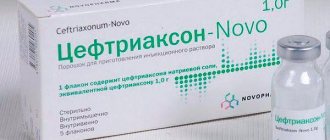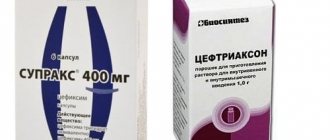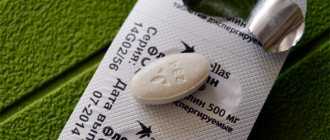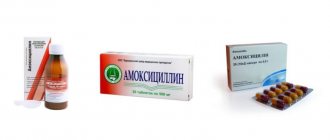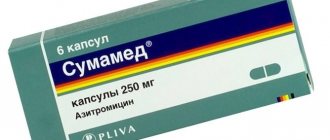Ceftriaxone against purulent tonsillitis: what doctors recommend in this fight
Purulent tonsillitis in a child or adult is easy to diagnose.
After all, humanity has been familiar with this disease since ancient times. There are many treatment methods, but sore throat was cured only in the 20th century with the advent of the first antibiotics. Examination by a doctor is a very important event.
Sore throat is an infectious inflammation in the upper respiratory tract. The acute process is caused by beta-hemolytic streptococci. In second place is Staphylococcus aureus. Occasionally, the culprit is E. coli, the causative agents of syphilis and gonorrhea, or representatives of opportunistic flora. The process affects the tonsils, mucous membranes of the larynx, and nearby lymph nodes.
The main symptoms of angina:
- acute onset with an increase in temperature to critical values;
- aching joints;
- general intoxication;
- chills and weakness;
- hyperemia of the mucous membranes of the pharynx;
- a sore throat. A characteristic symptom is sharp bilateral pain when swallowing. Without this symptom, the diagnosis of “angina” is considered doubtful;
- nearby lymph nodes are enlarged and painful;
- there are no skin rashes;
- with purulent tonsillitis, lacunae filled with purulent contents form in the tissues of the tonsils.
Treatment method for sore throat
Sore throat is fraught with various complications. It causes rheumatic changes in the heart and joints, diseases of the kidneys and urinary system. Therefore, the question of treating or not treating purulent tonsillitis does not even arise.
Treatment strategy and tactics:
- cephalosporin antibiotics or penicillin and its analogues;
- local antiseptics;
- rinsing the mouth with herbal decoctions and antiseptic solutions;
- sensitizing drugs;
- probiotics;
- general health-improving medications and various vitamin complexes;
- physiotherapy procedures.
How to quickly treat a sore throat at home? Or is it just a hospital and there is no other way out? Treating purulent sore throat at home is allowed only if all doctor’s recommendations and bed rest are followed.
Remember! The patient is a source of infection for others. By carrying a sore throat on your feet, you infect other people and harm your own health!
Get treatment on time to avoid complications
Antibiotic "Ceftriaxone": instructions
Antibiotics for sore throat are a mandatory standard of treatment.
The drug is prescribed by the attending physician. One of the well-proven remedies is the antibiotic Ceftriaxone.
Commercial form – transparent bottles with a dosage of the active substance of 500 mg, 1 and 2 g.
This substance has a wide spectrum of action, which allows you to quickly cure a sore throat. Ceftriaxone acts on:
- staphylococci and streptococci, including penicillin-resistant species;
- Escherichia coli and Proteus;
- various types of enterococci, except Enterorococcus fecalis;
- Klepsiela and Morganella.
The drug has 100% bioavailability. Penetrates into all soft tissues, bone structures, cerebrospinal fluid, membranes of the brain, passes through the placental barrier, and peritoneal organs. The maximum concentration in the blood is achieved 2 hours after intramuscular injection, and immediately after intravenous infusion.
Antibiotics for children with sore throat are administered intramuscularly, in severe cases - intravenously. The latter method is used only in hospital settings. The remains of the drug and its metabolites are excreted by the kidneys.
Effective dosages of antibiotics for angina for an adult patient and a child are selected by the doctor depending on the age and severity of the process:
- Adults and children over 12 years old – 1 bottle of 1 g of active ingredient 2 times a day, once every 12 hours.
- Antibiotics for sore throat in children under 12 years of age, the dosage is calculated according to weight. The manufacturer recommends 500 mg 2 times a day.
- For newborn toddlers, the dose ranges from 20 to 50 mg per 1 kg per day, divided into 2 doses.
The course of treatment is at least 5 days. In severe cases - from 7 to 10 days.
Take the drug and follow the dosage as directed by your doctor
How to use the medicine correctly
The drug is available in the form of a dry powder for preparing a solution.
Injecting an antibiotic into a muscle is a rather painful procedure, so only water for injection or saline solution is not used when diluting the drug.
Ceftriaxone should be diluted for intramuscular administration with the following solvents:
- distilled water 1 ampoule or 2 ml saline solution;
- 1 ampoule of lidocaine.
Ceftriaxone must be diluted following certain rules:
- Wash the hands.
- On the table, prepare a 5 ml syringe, 1 ampoule of water or saline solution, 1 ampoule of lidocaine.
- Carefully open the ampoules. Use a special saw for cutting glass.
- Fill the syringe with the entire volume of water and lidocaine.
- Use a needle to pierce the rubber stopper on the Cefriaxon bottle.
- Add a mixture of water and lidocaine into the vial. Stir thoroughly. The powder should completely dissolve, the solution should become transparent without inclusions. The color of Ceftriaxone in liquid form can range from colorless to pale yellow. Do not remove the needle from the bottle.
- Connect the cannula of the syringe and draw up the solution. All is ready.
For intravenous infusions, you will need from 5 to 40 ml of water or saline, depending on the dose of the drug. The prepared solution is stored for 6 hours. So before each injection you should prepare a fresh solution.
Contraindications and side effects
This antibiotic for sore throat is quite well tolerated. There are few contraindications to the use of this drug:
- individual intolerance to Ceftriaxone;
- Prescribe the drug with caution to persons diagnosed with a history of allergies to drugs of the “antibiotics” group.
Pregnancy and lactation are a relative contraindication. If the expected effect of using an antibiotic exceeds the danger to the child, then it is used as prescribed by a doctor.
During pregnancy, ALWAYS consult your doctor; do not make your own decision about taking antibiotics.
Side effects of Ceftriaxone:
- impaired renal excretory function;
- dyspepsia – nausea, vomiting, diarrhea, epigastric pain, liver dysfunction;
- oral cavity and other mucous membranes – fungal infections, development of opportunistic microflora;
- cardiovascular system – thrombosis, development of iron deficiency conditions, increase in prothrombin time;
- allergic reactions;
- local reactions - with intravenous administration there is pain along the vein, with intramuscular administration - pain, bruises at the injection site.
If side effects occur, you should inform your doctor. Some of them - nausea, diarrhea - do not require discontinuation of the drug or additional therapeutic measures. In other cases - impaired hematopoietic functions, impaired production of liver enzymes - the antibiotic is canceled.
special instructions
Purulent sore throat should be treated with Cefriaxon under the supervision of a doctor.
- Important! The drug is incompatible with ethyl alcohol - a disulfaram reaction develops.
- Do not mix with other antibiotics and medications in 1 syringe or dropper.
- The simultaneous use of drugs from the NSAID group - paracetamol, denebol and others - with cephalosporins increases the risk of gastric bleeding.
- Do not use simultaneously with diuretics. This will put additional stress on the kidneys and increases the likelihood of side effects in the urinary system.
- In patients on hemodialysis, the concentration of antibiotic in the blood should be monitored.
- The drug does not impair attention and the ability to operate precision machinery and cars.
Some conclusions
- The drug allows you to quickly cure purulent tonsillitis in both adult patients and children.
- Intramuscular injections are carried out both in medical institutions and at home. Intravenous drip administration is indicated in severe cases and is carried out only in a hospital setting.
- It is impossible to cure purulent sore throat with just one antibiotic; an integrated approach and medical supervision are required.
Do not search the Internet for information about what helps with sore throat. This is a dangerous disease with long-term consequences.
Contact a medical facility and complete the full course of treatment.
Source: https://nasmorkoff.ru/medications/ceftriakson-protiv-gnojnoj-anginy-chto-rekomenduyut-vrachi-v-etoj-sxvatke/
Antibiotic "Ceftriaxone": instructions
Antibiotics for sore throat are a mandatory standard of treatment.
The drug is prescribed by the attending physician. One of the well-proven remedies is the antibiotic Ceftriaxone.
Commercial form – transparent bottles with a dosage of the active substance of 500 mg, 1 and 2 g.
This substance has a wide spectrum of action, which allows you to quickly cure a sore throat. Ceftriaxone acts on:
- staphylococci and streptococci, including penicillin-resistant species;
- Escherichia coli and Proteus;
- various types of enterococci, except Enterorococcus fecalis;
- Klepsiela and Morganella.
The drug has 100% bioavailability. Penetrates into all soft tissues, bone structures, cerebrospinal fluid, membranes of the brain, passes through the placental barrier, and peritoneal organs. The maximum concentration in the blood is achieved 2 hours after intramuscular injection, and immediately after intravenous infusion.
Antibiotics for children with sore throat are administered intramuscularly, in severe cases - intravenously. The latter method is used only in hospital settings. The remains of the drug and its metabolites are excreted by the kidneys.
Effective dosages of antibiotics for angina for an adult patient and a child are selected by the doctor depending on the age and severity of the process:
- Adults and children over 12 years old – 1 bottle of 1 g of active ingredient 2 times a day, once every 12 hours.
- Antibiotics for sore throat in children under 12 years of age, the dosage is calculated according to weight. The manufacturer recommends 500 mg 2 times a day.
- For newborn toddlers, the dose ranges from 20 to 50 mg per 1 kg per day, divided into 2 doses.
The course of treatment is at least 5 days. In severe cases - from 7 to 10 days.
Take the drug and follow the dosage as directed by your doctor
"Ceftriaxone" for sore throat in adults and children: dosage and how many days to inject
The antibiotic "Ceftriaxone" is prescribed for bacterial sore throat. The medicine is available in the form of a solution for intravenous or intramuscular administration. Even newborn patients are allowed to be treated. You should first read the instructions, which describe in detail the cases of prescription, possible side effects and contraindications.
Description of the drug
The drug "Ceftriaxone" belongs to the group of cephalosporin antibiotics. After intravenous or intramuscular administration, the components of the drug quickly destroy the membrane of pathogenic microorganisms. Thanks to this, improvement in the condition becomes noticeable after the first day of treatment.
The medicine is available in the form of a white powder in a transparent bottle with a capacity of 10 and 20 ml. To dilute the powder, use a special injection liquid. Since the injection is painful, the powder can be diluted with an anesthetic. A 1% solution of Lidocaine is suitable.
If the bottle contains 0.5 g of powder, then add 2 ml of liquid. 3.5 ml of solvent is poured into a bottle with 1 g of antibiotic.
Indications and contraindications
Ceftriaxone is most often prescribed when other penicillin antibiotics in the form of tablets and suspensions do not help. Injections with the drug are given not only for purulent sore throat, but also in other cases:
- skin infectious diseases;
- meningitis;
- inflammatory processes in the ENT organs;
- infectious foci in the urinary, motor or digestive system;
- infection of wounds and abrasions.
Ceftriaxone should not be used in the following cases:
- the presence of hypersensitivity to the constituent components;
- serious pathologies of the liver and kidneys;
- a limitation for newborns is jaundice;
- diseases of the small and large intestines.
Important recommendations to follow during therapy:
- During treatment you should stop drinking alcohol.
- You cannot simultaneously mix other antibacterial drugs in the same bottle with Ceftriaxone.
- You cannot take diuretics while receiving injections, as the load on the kidneys increases.
- The use of Ceftriaxone with non-steroidal anti-inflammatory drugs can lead to disruption of platelet production.
If you follow all the recommendations and rules for diluting the drug, it will be possible to minimize unwanted manifestations from the body.
Instructions for use
The permissible single dosage is 1 g of the drug. If the sore throat is severe, then intravenous administration is indicated. If a larger dosage is required, it is administered dropwise over 30 minutes.
Rules for diluting the drug:
- Before carrying out the procedure, be sure to wash your hands with soap;
- prepare a 5 ml syringe, an ampoule with saline solution or a special liquid for diluting injections and an ampoule with Lidocaine;
- all ampoules are carefully opened;
- the recommended volume of liquid and “Lidocaine” are drawn into the syringe;
- then pierce the bottle with the powder with a needle, pour in the liquid and shake well without removing the needle.
- only after this the finished drug in the recommended quantity is drawn into a syringe.
Shake the bottle of powder until all particles of powder dissolve. The finished solution retains all its medicinal properties for no more than 6 hours, so fresh medicine is prepared for each injection:
- For adult patients and adolescents over 12 years of age, the dosage is 1-2 g per day.
- If the patient's condition is severe, the dosage can be increased to 4 g, divided into two doses with an interval of 12 hours.
- For children under one year of age, the dosage is calculated based on body weight. Often 50 mg of the drug is prescribed per 1 kg of weight.
- For children under 12 years of age, the dosage is 1-2 g, divided into two doses.
For young children, antibiotics are prescribed in rare cases, only when a sore throat is accompanied by purulent, inflammatory processes.
Advice. Before administering the drug to children, it is advisable to conduct an allergy test.
A small scratch is made on the shoulder, onto which a few drops of an antibacterial solution are applied. If after an hour no reactions have occurred, the medicine can be injected without fear.
Side effects
The risk of developing adverse reactions increases if the dosage and other recommendations are not followed. The most common adverse reactions from the body include:
- disturbances in the functioning of the cardiac, urinary and circulatory systems;
- the appearance of nausea, vomiting, abdominal pain, stool disorders;
- intestinal dysbiosis;
- development of fungal infection;
- exacerbation of allergies, which manifests itself as rash, redness and itching of the skin;
- pain, swelling and redness at the injection site;
- headaches, dizziness, nosebleeds.
If the medicine is administered through a vein, the venous wall may become inflamed. At the injection site there is swelling, redness, and pain.
Course duration
Only the doctor decides how many days to inject the medicine. The severity of the disease, the patient’s age and concomitant diseases are taken into account. In most cases, the course of treatment lasts from 5 to 10 days.
Even if the condition improves, therapy cannot be stopped. If the medication is stopped, there may be a relapse of the disease and a greater likelihood of complications.
Use of the drug during pregnancy
The drug is rarely prescribed during pregnancy. Treatment is permissible only if the benefit outweighs the harm to the development and growth of the fetus:
- The drug "Ceftriaxone" is completely contraindicated in the first trimester of pregnancy. At this time, the laying of all vital organs is underway; the placenta is just being formed and does not fulfill its protective functions. All components of the medicine penetrate to the fetus. The likelihood of spontaneous miscarriage increases.
- At later stages of pregnancy, when all the important organs and systems of the fetus are formed, and the placenta performs its protective function to the maximum, the drug will not be able to cause serious harm. Therefore, if pregnancy proceeds without complications, in the second trimester Ceftriaxone can be prescribed for sore throat.
- It is dangerous to prescribe Ceftriaxone in the third trimester. At this time, the kidneys experience greater stress, and the likelihood of exacerbation of chronic pathologies increases. Preeclampsia develops against the background of antibiotics.
If there is a need to prescribe the drug during breastfeeding, then the child is temporarily transferred to formula feeding.
Kalashnik Yulia
306
Source: https://VipLor.ru/gorlo/tonzillit/tseftriakson-pri-angine
Contraindications and side effects
This antibiotic for sore throat is quite well tolerated. There are few contraindications to the use of this drug:
- individual intolerance to Ceftriaxone;
- Prescribe the drug with caution to persons diagnosed with a history of allergies to drugs of the “antibiotics” group.
Pregnancy and lactation are a relative contraindication. If the expected effect of using an antibiotic exceeds the danger to the child, then it is used as prescribed by a doctor.
During pregnancy, ALWAYS consult your doctor; do not make your own decision about taking antibiotics.
Side effects of Ceftriaxone:
- impaired renal excretory function;
- dyspepsia – nausea, vomiting, diarrhea, epigastric pain, liver dysfunction;
- oral cavity and other mucous membranes – fungal infections, development of opportunistic microflora;
- cardiovascular system – thrombosis, development of iron deficiency conditions, increase in prothrombin time;
- allergic reactions;
- local reactions - with intravenous administration there is pain along the vein, with intramuscular administration - pain, bruises at the injection site.
If side effects occur, you should inform your doctor. Some of them - nausea, diarrhea - do not require discontinuation of the drug or additional therapeutic measures. In other cases - impaired hematopoietic functions, impaired production of liver enzymes - the antibiotic is canceled.
Ceftriaxone course of treatment for sore throat
Ceftriaxone for angina is administered 1-2 g per day for 7-10 days intramuscularly or intravenously, it is diluted with 1% lidocaine or water. For children, the daily dose is calculated per 1 kg of weight: 20-50 mg up to 2 weeks, 20-80 mg up to 12 years. Prescribed only by a doctor, administered once a day.
The drug destroys bacteria that cause inflammation of the tonsils, eliminates the main symptoms: fever, sore throat, swollen lymph nodes. The antibiotic prevents complications of the disease - the spread of infection to the kidneys and heart.
Contraindicated in case of intolerance, jaundice of newborns, do not use together with calcium. The drug is used with caution during pregnancy and lactation. The most common adverse reactions are diarrhea, rash and changes in blood tests.
How Ceftriaxone will help with angina
Ceftriaxone for angina destroys bacteria that cause inflammation of the tonsils, it helps:
- reduce body temperature;
- improve general condition - reduce headaches, relieve aches in joints and muscles that are associated with intoxication (penetration of toxic waste products of microbes into the blood);
- relieve sore throat and difficulty swallowing;
- gradually eliminate enlargement and pain of the cervical lymph nodes;
- prevent local complications: otitis (ear inflammation), damage to the lymph nodes, swelling of the tissues around the tonsils, as well as the spread of infection to the kidneys (glomerulonephritis), heart (rheumatic carditis), joints (rheumatism);
- reduce the risk of infecting others.
This drug has a wide spectrum of antibacterial action; resistance to it is less common than to penicillin drugs. In most cases, for angina, it is prescribed even before the results of bacteriological culture and identification of the pathogen, then the treatment regimen may be changed.
Is it always possible to inject
Ceftriaxone can be injected for angina of various clinical forms (see table).
| Type of sore throat | Signs | When to Expect Improvement | Course of treatment (minimum and maximum) |
| Catarrhal | Fever up to 38C, moderate intoxication, red throat | By the end of 1 day | 5-7 days |
| Follicular | Temperature 38.5-40 degrees, sweating, pain throughout the body, and the throat may hurt only for 2-3 days, difficulty swallowing, radiates into the ear (“shoots”), painful lymph nodes, enlarged tonsils with ulcers | For 3-4 days | 10-14 days |
| Lacunarnaya | Temperature 38-39C, chills, body aches, headache, pain when swallowing, turning the neck, opening the mouth, unpleasant odor, redness and swelling of the tonsils, yellowish coating (purulent films) | On day 2 | 7-10 days |
| Necrotic | Temperature from 39 to 40 and above, confusion, vomiting, gray or greenish coating on the tonsils, uneven (“pockmarked”) surface, spread of inflammation to adjacent tissues | By 3-5 days (injections into a vein) | 14 days, then change antibiotic and another 7 days |
The course of angina may differ in children, elderly and debilitated patients. Therefore, you cannot focus only on temperature or symptoms of the disease, or use antibiotics yourself. It is mandatory to examine a doctor and monitor blood and urine tests, culture to determine the pathogen and its sensitivity to the antibiotic.
Advantages and disadvantages of application
Ceftriaxone has advantages in the treatment of angina:
- acts faster than tablets, can be injected into a vein or intramuscularly;
- it is necessary to inject only once a day (most antibiotics require 2-6 times of application);
- destroys the most common pathogens of sore throat (streptococci, staphylococci, pneumococci, Haemophilus influenzae, moraxella), including those that produce protective enzymes (beta-lactamases);
- can be used for stomach diseases, vomiting (this can make it difficult to take pills).
The disadvantages of the drug include administration only by injection, which cannot always be done independently and at home, their pain and the risk of local complications - hardening of the injection site, less often inflammation and suppuration (gluteal abscess).
Contraindications for use
Ceftriaxone has relatively few contraindications and is well tolerated, but should not be prescribed:
- in case of intolerance to the active substance;
- if you are allergic to cephalosporin antibiotics and penicillins in the past, severe forms of a drug allergic reaction (such patients definitely need a test before administration);
- newborns: premature (total period of gestation and life 41 weeks or less), up to 1 month full-term with jaundice, increased bilirubin;
- for young children with simultaneous administration of solutions with calcium.
We recommend reading the article on how to use Ceftriaxone for sinusitis. From it you will learn why Ceftriaxone is prescribed for sinusitis, sinusitis and other ENT diseases, as well as how to properly inject the antibiotic and what to do if it does not help.
And here is more information about whether Ceftriaxone can be taken during pregnancy.
Is it possible to take an antibiotic if you have a fever?
The antibiotic is indicated at elevated temperatures against the background of sore throat, as it is a manifestation of intoxication syndrome (poisoning with bacterial toxins). The drug destroys microbes because it prevents the formation of their cell membrane. After the growth and development of bacteria stops, the temperature response also decreases.
If the patient’s condition is serious, especially in childhood, in addition to the drug, antipyretics (for example, Ibuprofen or Paracetamol) may be prescribed. They are used for no more than 2-3 days until Ceftriaxone itself begins to act effectively.
If a fever persists for more than 3 days during treatment with such a strong antibiotic, then this is a reason to urgently consult a doctor, since a persistently elevated temperature occurs with:
- insensitivity of bacteria (need to change medication);
- mixed nature of pathogens (add another antibacterial drug);
- complications began (continued therapy in the hospital is required).
Source: https://cms-moscow.ru/ceftriakson-kurs-lechenija-anginy/
Contraindications of the drug
In case of renal failure, the antibiotic is contraindicated!
Ceftriaxone for angina is contraindicated in the following cases:
- Hypersensitivity or allergic reactions to cephalosporin antibiotics.
- Kidney failure.
- Liver failure.
- Nonspecific ulcerative colitis.
- Colitis caused by antibiotic use.
- Enteritis.
- Other diseases of the digestive system, especially severe or chronic.
- In newborns with hyperbilirubinemia.
- Pregnancy, especially in the first trimester.
The decision to prescribe Ceftriaxone to a small child is made by the attending physician, based on the severity of his condition. Typically, a drug is prescribed only if the expected benefit is significantly greater than the possible risks of using this antibiotic.
When using the product for the first time, it is necessary to perform a simple allergy test to avoid an unexpected negative reaction. Otherwise, it can turn out to be very violent and unpredictable, posing a real threat to the life and health of the patient.
You can learn more about how to properly dilute antibiotics from the video:
OKI solution for gargling and rules for its use
To carry out the test, a small amount of the drug is injected under the patient's skin. If swelling, redness, rash or inflammatory reaction is observed at the injection site, Ceftriaxone should not be used.
The medicine is highly effective, but can cause serious harm to health. When prescribing it, the doctor takes into account all possible contraindications, so during his appointment there is no need to hide your illnesses and the presence of previously manifested negative effects from the use of other antibiotics.
Possible side effects
When using Ceftriaxone for angina, you can get some side effects. Most of them are mild and quite rare. Most often, such manifestations go away on their own or after discontinuation of the drug.
Improper use of the drug may cause nausea, vomiting and diarrhea.
The most common side effects from this antibiotic are:
- Nausea, vomiting, indigestion, diarrhea.
- Glossitis, stomatitis.
- A change in the blood formula is detected during testing.
- Manifestations of allergies, mainly in the form of skin rashes, dermatitis, urticaria, severe itching and swelling. Dangerous reactions in the form of exudative erythema multiforme are rare.
- Headache and dizziness.
- Anaphylactic reactions are quite rare, as are the appearance of chills, fever, development of “thrush” and other mycoses of the mucous membranes and genital organs.
- Very rarely, phlebitis and pain may develop at the injection site if the injection is too rapid. This can be avoided by inserting slowly and using a fine needle.
When used correctly, the drug turns out to be very effective against sore throat and does not have a negative effect on the patient’s body.
Ceftriaxone is rarely used independently for the treatment of angina; it is mainly used as part of complex therapy as the most effective remedy. Its antibacterial effect is complemented by antipyretic, analgesic, antihistamine and anti-inflammatory drugs, and local therapy.
What are the consequences of an overdose of aspirin?
Ceftriaxone - first aid for sore throat
Ceftriaxone is one of the serious antibiotics for treating bacterial infections. Ceftriaxone is used for sore throat in adults and children, as an urgent treatment for conditions requiring emergency care, such as high persistent fever or deterioration of health due to the ineffectiveness of previous forms of prescribed antibiotics.
The antibiotic Ceftriaxone belongs to the group of third generation Cephalosporins, which have a wide spectrum of action. Available in the form of a powder for injection, which is diluted with an anesthetic solution of Lidocaine or sterile water for injection, depending on the purpose for which the solution is used: for intravenous or intramuscular administration.
After intramuscular injection, the highest concentration is reached 2 hours after administration of the drug, and after infusion - at the end of the procedure, therefore Ceftriaxone is often prescribed in the form of intravenous drips and injections.
Features of the drug
Features of treatment with Ceftriaxone include the following points:
- A diluted solution for intramuscular administration is not suitable for intravenous use due to the lidocaine content in it.
- Storing the finished solution
Any prepared solutions cannot be stored; they must be used immediately after preparation. However, in practice it was found that 6-hour storage in the refrigerator does not affect the effectiveness of the drug, only the color changes from light yellow to a more saturated shade of yellow.
Detailed studies have not been conducted on the effect of the antibiotic Ceftriaxone on the fetus, so use, if considered possible, is after an adequate assessment of the harm to the baby and the essential benefit to the mother.
Ceftriaxone passes into breast milk, so the doctor may advise you to stop breastfeeding for the duration of treatment if there is no possibility of replacing the antibiotic with another, gentler drug of similar action.
Children are injected with Ceftriaxone, if necessary, from the first days of life. Ceftriaxone for angina is prescribed to children if other antibiotics do not cope with the disease or the case of the disease can be called advanced.
Antibiotic injections should not be given if the patient is allergic to Ceftriaxone, Lidocaine and Penicillin. Before using the injection, a “test” is required on the skin.
Dosage
How to dilute Ceftriaxone correctly?
- For intramuscular injections, a bottle with 1 gram of powder is combined with 3.5 ml of a one percent solution of Lidocaine. As a rule, an anesthetic is drawn into a syringe, the rubber cap of a bottle with powder is pierced with a needle, and the collected anesthetic liquid is poured into it. After shaking the bottle, as well as completely dissolving the powder, the solution is ready for use.
The syringe needle must be inserted deep into the buttock muscle, but no more than 1 gram into each muscle, so alternating injection sites is required.
- For intravenous injection, combine 1 gram of Ceftriaxone with 10 ml of sterile water. To avoid troubles such as phlebitis, the solution is administered slowly, preferably at least 2 minutes per injection.
- For droppers, you will need 2 grams of antibiotic, 0.9% saline solution and at least half an hour of time to administer the prepared solution.
Dosage of the antibiotic Ceftriaxone for angina
Dosage
| Adults and teenagers | 1-2 grams administered once or twice a day. |
| Children from two weeks to 12 years | From 20 to 80 mg per kg of the child’s body weight, once a day; for purulent sore throat, the doctor may recommend using injections twice a day. |
| Elderly patients | The usual adult dose is required without adjustment. |
How many days should I inject Ceftriaxone?
It is better to continue treatment of sore throat with Ceftriaxone until the acute symptoms of the disease disappear, as well as for another 2-3 days in order to prevent complications or begin to combat them.
The exact course of treatment is determined only by the doctor who prescribed this antibiotic drug.
Ceftriaxone analogs
This cephalosporin antibiotic really serves as a real “first aid” in the treatment of complex infectious diseases. If it becomes impossible to continue treatment with Ceftriaxone, a similar effect can be obtained from its analogues:
- Avekson;
- Auroxon;
- Blicef;
- Bresek;
- Loraxone;
- Norakson;
- Rotacef;
- Cefaxon;
- Cefazolin;
- Cefotaxime;
- Cephogram;
- Effectal.
If treatment with this antibiotic becomes unrealistic due to allergies, it is replaced with Macrolides.
Source: https://anginano.ru/preparaty/ceftriakson.html
What is this drug?
Ceftriaxone is an antibacterial agent that is used only parenterally, i.e. it is intended for intramuscular and intravenous use. Doctors note that Ceftriaxone can be used both for adult patients and for young children and even newborns. The drug belongs to the 3rd generation cephalosporin antibiotic substances and has less effect on the body compared to other drugs. Due to this, it has a negative effect on bacteria of the penicillin and simple cephalosporin series.
Usually the drug is prescribed by a specialist when the patient cannot use penicillin antibiotics, when the disease has reached an advanced stage, when the use of other antibiotics in the form of tablets, capsules and suspensions is not recommended for the patient.
Ceftriaxone is prescribed by a specialist not only for purulent tonsillitis, but also for the treatment of the following diseases:
- various infections on the surface of the skin and soft tissues;
- when diseases such as streptoderma, meningitis, gonorrhea appear;
- with the development of an inflammatory process in the cavity of the ear canals and sinuses;
- in the presence of chronic tonsillitis;
- when an infection occurs in the digestive, motor and urinary systems;
- in the presence of infectious lesions of wounds and burns;
- with a sharp decrease in the activity of the immune system;
- in the presence of bacterial pharyngitis and abscess in the pharynx.
Ceftriaxone for sore throat: how many days to inject the antibiotic
The doctor prescribes Ceftriaxone for angina when it is caused by bacteria such as pneumococci, Haemophilus influenzae, gononcocci or moraxella.
The antibiotic has a bactericidal effect and is able to quickly destroy the cell membrane of the infectious cell.
Thanks to this, the drug has a therapeutic effect after the first use and has only positive reviews from patients.
What is this drug?
Ceftriaxone is an antibacterial agent that is used only parenterally, i.e. it is intended for intramuscular and intravenous use.
Doctors note that Ceftriaxone can be used both for adult patients and for young children and even newborns.
The drug belongs to the 3rd generation cephalosporin antibiotic substances and has less effect on the body compared to other drugs. Due to this, it has a negative effect on bacteria of the penicillin and simple cephalosporin series.
Usually the drug is prescribed by a specialist when the patient cannot use penicillin antibiotics, when the disease has reached an advanced stage, when the use of other antibiotics in the form of tablets, capsules and suspensions is not recommended for the patient.
Ceftriaxone is prescribed by a specialist not only for purulent tonsillitis, but also for the treatment of the following diseases:
- various infections on the surface of the skin and soft tissues;
- when diseases such as streptoderma, meningitis, gonorrhea appear;
- with the development of an inflammatory process in the cavity of the ear canals and sinuses;
- in the presence of chronic tonsillitis;
- when an infection occurs in the digestive, motor and urinary systems;
- in the presence of infectious lesions of wounds and burns;
- with a sharp decrease in the activity of the immune system;
- in the presence of bacterial pharyngitis and abscess in the pharynx.
How to treat a sore throat with Ceftriaxone
The antibiotic is sold in sterile powder, which is intended for the preparation of an injection solution. This powder is placed in a special bottle. The container can have a volume of 10 and 20 ml. Depending on the volume, the antibiotic in the package is contained in a dosage of 0.5, 1 and 2 grams. For injections, only fresh solution should be used
Solution recipe and dosage
The powder is diluted with a special liquid for injection. This leads to pain in the patient during the injection. To dilute the powder, doctors recommend using an anesthetic: 1% lidocaine solution.
The product is dissolved as follows: about 2 ml of solvent should be added to a bottle with an antibiotic substance in a volume of 0.5 g, which is intended for intramuscular administration. If a product with 1 g of antibiotic is used, then about 3.5 ml of liquid is added.
Another variation in preparing the solution
- Experts note that no more than 1 g of antibiotic substance should be administered per injection.
- If the patient develops a severe sore throat, the drug is also administered intravenously.
The product can also be injected as a jet, and the injection is carried out for 2 to 4 minutes. About 0.5 g of antibiotic substance is injected into the vein cavity. - If the patient needs a large dose of the drug (about 2 grams), then it is administered by drip. The injection is carried out intravenously for about half an hour. In this case, the antibiotic is diluted in an isotonic sodium chloride solution or in a glucose solution.
Attention.
It is not permissible to use liquids containing calcium to dilute the medicine. Patients should remember that it is not advisable to mix different antibiotic substances in one bottle.
Getting ready for the injection
Before use, you should follow these simple rules:
- Wash your hands well with soap.
- There should already be a 5 ml syringe, 1 ampoule of water or physical solution, 1 ampoule of lidocaine on the table.
- All ampoules are carefully opened, and the entire volume of liquid and lidocaine is drawn into the syringe.
- You need to use a needle to make a puncture in the rubber stopper with an antibiotic substance. After this, water and lidocaine are introduced into the bottle with the product.
- Stir the solution well, but do not remove the needle.
- After this, the required amount of the finished product is drawn into the syringe.
How to use correctly
The instructions for use, which are contained in each package of the antibiotic Ceftriaxone, describe how to inject it correctly.
This should be done according to the following scheme:
- Adults and children over 12 years of age should use the product about 1 time per day - the dosage is 1-2 grams.
- If the disease is in an advanced stage, the dosage of the drug per day is about 4 grams.
This amount is divided into 2 doses per day every 12 hours. - For newborns up to 14 days, the drug is prescribed in a dosage of 20-50 mg per 1 kg of weight. Injections are given once a day.
- For infants and children under 12 years of age, the drug is prescribed in a dosage of 20-80 mg per 1 kg of weight.
- If the child weighs more than 50 kg, then the dose is the same as for an adult patient.
- If treatment is given to children under 12 years of age, the dose is divided by half.
The child is injected with the drug 2 times a day with an interval of every 12 hours. The product has rapid absorption, due to which various seals do not appear on the patient’s body. - Ceftriaxone for angina in adults can be used in a dosage of 50 mg per 1 kg of weight, then the drug is administered intravenously and preferably by drip. The whole process takes about 30 minutes.
- When injecting the medication into a vein, the entire procedure takes from 2 to 4 minutes.
In this video, Roman Zharkov will tell you how to properly prepare a Ceftriaxone solution for injection, as well as about the differences between Lidocaine and Novocaine. Question from patients to the doctor: “How many days should I inject Ceftriaxone?”
- the duration of use and dosage are prescribed only by the attending physician;
- usually the product is used for 5 to 10 days;
- when the body temperature stabilizes, the product is used for another 2-3 days;
- The patient should not stop using the antibiotic until the entire course is completed, unless otherwise prescribed by the doctor.
This can lead to the patient developing resistance to the substances included in the drug and to a re-exacerbation of the disease, relapse and complications.
Features of use in children
Doctors note that before prescribing an antibiotic to young children, it is recommended to do a small test: an injection is given with 0.5 ml of the drug containing lidocaine. Next they look at the baby’s condition. If the child does not show any unpleasant symptoms after half an hour, then a residual dose of the drug can be administered.
The child can also undergo a scratch test. It is considered the safest. The procedure is as follows: small scratches are made on the shoulder and the product is dripped into them. If after some time no redness or swelling appears, the drug can be used further.
Precautionary measures
Experts note that Ceftriaxone should not be used:
- if the patient has hypersensitivity to cephalosporins, carbapenems and penicillins;
- development of renal and liver failure;
- for babies with newborn jaundice;
- if the patient has diseases in the large and small intestines.
In order to prevent the occurrence of dangerous side effects and the development of serious illnesses, the following recommendations should be followed:
- do not use together with substances containing ethanol;
- completely give up bad habits;
- Do not use the drug together with other antibiotic substances, as well as with “loop” diuretics, nephrotoxic drugs. This is due to the fact that their combined use can lead to nephrotoxic effects on the body.
The use of the drug together with non-steroidal anti-inflammatory drugs and antiplatelet agents may disrupt the process of platelet aggregation. This may cause the patient to bleed. In order to avoid this, doctors usually prescribe vitamin K to elderly and severely weakened people. An alternative to taking pharmacy vitamins
What's the end result?
Ceftriaxone is usually prescribed for the treatment of severe purulent tonsillitis when the patient requires emergency therapy. The use of medicine in a patient often causes discomfort, especially during injections.
In this regard, many patients, especially children, refuse injections and this is wrong. The drug really quickly helps to get rid of the disease and reduce the risk of complications and the development of dangerous diseases.
Therefore, during treatment, the patient should endure some discomfort, as this is important for his health.
Source: https://garganta.ru/lechenie/ceftriakson-pri-angine.html
When should you use Ceftriaxone?
The antibiotic is widely used in ENT practice, this is due to the fact that the pathological bacteria that live in these organs belong to the spectrum of the antimicrobial effect of the drug.
Ceftriaxone is used for acute tonsillitis in the absence of sensitivity to other antibacterial drugs. The remedy has a good effect in the treatment of complications of purulent tonsillitis. The presence of paratonsillitis or the formation of an abscess in this area requires immediate administration of Ceftriaxone. After just a few injections, the temperature drops, sore throat and intoxication symptoms subside, redness and swelling of the tonsils decreases.
The drug is used in cases of severe inflammatory diseases of the nose caused by bacterial flora. This occurs in acute sinusitis, frontal sinusitis, ethmoiditis and sphenoiditis. Often, pathogens that invade the paranasal sinuses during sinusitis are not sensitive to unprotected antibiotics.
It is advisable to prescribe Ceftriaxone for angina when the bacterial flora is not sensitive to other antibiotics
Ceftriaxone destroys the cell wall of the pathogen, disrupts the proliferation of microbes, which leads to a decrease in the patient’s temperature, a decrease in pain in the head and sinuses, purulent nasal discharge, and improved breathing.
For a cough that accompanies bronchitis, or for laryngitis complicated by microbial flora, treatment with antibiotics is a prerequisite for recovery from the disease.
Acute purulent inflammation of the middle ear requires antibacterial therapy. Unprotected penicillin antibiotics do not always give the desired result. Ceftriaxone injections almost always have a positive therapeutic effect. It is prescribed for mastoiditis and other complications of acute purulent otitis media, including otogenic meningitis and sepsis.
The drug is effective in the treatment of bacterial sinusitis
In addition, Ceftricasone is used for:
- inflammation of the upper and lower respiratory tract;
- bacterial infections of the abdominal organs;
- microbial lesions of bones, joints, skin, soft tissues;
- the presence of pathogens in the urinary tract and reproductive system;
- meningitis;
- endocarditis;
- sepsis;
- salmonellosis, etc.
After administration of Ceftriaxone for acute purulent otitis, positive dynamics of the disease are observed already on the second day
Prescribed for the prevention of infections after surgical interventions.
Course of use of Ceftriaxone
Depending on the form of angina and the severity of the disease, the doctor prescribes a course of Ceftriaxone. After all symptoms disappear, use of the drug continues for several more days. In no case should you stop or prolong taking the drug, as this may cause resistance of pathogenic bacteria and with subsequent treatment it will be much more difficult to get rid of the disease. Also, a full course of antibiotic therapy reduces the risk of developing possible complications.
Instructions for use
Ceftriaxone is used only after a doctor's prescription and preferably in a hospital setting, since the drug requires intramuscular or intravenous administration. If you need to use the drug at home, it is important to know how to dilute it correctly.
The drug is available in powder form of varying concentrations. To dilute the drug, you need to use Lidocaine or sterile water intended for injection. Instructions for preparing the solution:
- To prepare an injection for intramuscular administration, it is necessary to dilute 0.5 g of the drug in 2 ml of solution or dilute 1 g of the drug in 3.5 ml of solution, depending on the prescribed dosage.
- For intravenous administration, only sterile water is used as a solvent: 0.5 g of the drug is diluted in 5 ml of solvent, 1 g of the drug is diluted in 10 ml.
When administered intramuscularly, the patient may experience pain, so simultaneous use of an anesthetic is necessary. It is worth remembering that Ceftriaxone is incompatible with cardiac medications, although its use is safe when combined with diuretic medications.
This antibiotic is a potent drug that cannot be combined with other antibacterial agents.
Ingoda, Novocaine can be used instead of Lidocaine to dilute the solution, but in this case the effect of the drug may be slightly reduced with a simultaneous increase in the risk of developing anaphylactic shock . Most patients noted that Lidocaine has a much better analgesic effect when administered.
After diluting the solution, the drug must be used immediately or within several hours, since the finished solution retains its properties at room temperature for no more than 6 hours.
